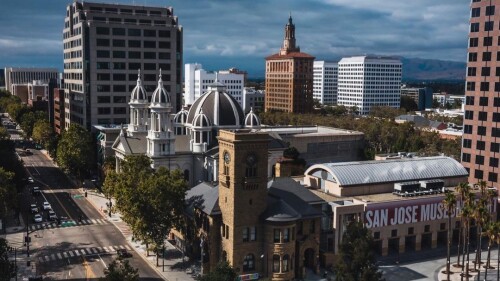On Wed., Aug. 31, hundreds of San Joseans came out to City Hall for a huge celebration marking the end to a 30-year ban on cruising, which disproportionately targeted San Jose’s Chicano community.
Efforts to repeal the ban were led primarily by the United Lowrider Council of San Jose (ULCSJ), whose members were at the center of this historic moment.
Today, we spoke with ULCSJ President David Polanco about the organization’s mission, its charitable work, and the role it’s playing in a growing lowrider movement across California (and beyond).

The August 31, 2022 celebration was a huge moment in our city’s history.
Video by ir.cinema + sj.shooters
👀 Changing perceptions
For David Polanco, there wasn’t a clear “first experience” in the lowrider community — he was always helping his dad work on vintage cars, or enjoying music playing out of his cousins’ lowriders at family get-togethers.
Seeing the cars’ wire wheels, custom paint jobs, and sound systems — David felt inspired to work hard to one day own a similar car. “And those are the type of indirect positive role models that you have, [but] you don’t realize as a kid.”
However, he acknowledges that not every San Josean has these positive associations — through the years, lowriders were associated with sideshows, altercations, and gang activity.
“You can say that about most events and cultures in one way or another,” argued David — who noted excessive policing of the Chicano community after the 1986 cruising ban went into effect. “But to be zeroed in on as a culture and as a community, [...] it really wasn’t right.”
Beyond repealing the ban, one of the ULCSJ’s biggest missions has been to share the positive aspects of the culture with the broader San Jose community.
One of the most recent moments of seeing this change came during the San Jose Jazz Summer Fest when an older man came to their defense after someone criticized the ULCSJ’s official presence at the event.
“He just looked him in the eye and said, ‘That’s San Jose culture right there,’” David recalled. “I was really proud of that moment.”
🤝 A pillar of the community
During the height of the pandemic, the group stayed busy with birthday cruises, car shows for essential workers at Kaiser Permanente, and farmworker supply caravans. These days, they’ve partnered with Amigos de Guadalupe on cookouts, and giving kids haircuts + backpacks for back-to-school season.
But David notes, "[The lowrider community has] been doing this stuff for years [before the council], but it never got highlighted [or recognized] by the city officials.”
He believes that the biggest turning point was Estella Inda’s lowrider exhibit at the Martin Luther King Jr. Library (which inspired the new East Side Dreams exhibit).
Around this time, the ULCSJ was introduced to city leaders like Councilmember Raul Peralez + Joe Noonan who helped bridge the divide between the community and city officials.
"[With] everybody embracing us at that moment, it was like perfect timing — we just needed to step through the door as it was opened for us.”
💪 The “low and slow” movement grows
David believes that the cruising ban repeal wouldn’t have happened without the support of San Jose’s wider lowrider community — and the support of lowrider communities across the state.
“Other people saw us organizing, so everybody’s getting inspired from each other,” David said — citing similar repeals + movements in Sacramento, Santa Rosa, Wilmington, Stockton, Modesto, East LA, Inland Empire, Santa Ana, National City, and beyond.
🛻 Keep it rolling
With San Jose’s cruising ban repealed, the ULCSJ is ready to roll. They hope to open up council meetings to the public before the end of the year. Their plan? Going back to basics.
“We got to get back to what got us where we’re at,” said David, who is already planning community events at the Alum Rock + Hellyer library branches, along with a cruise sponsored by the Knight Foundation. He’s also keen on bringing back San Jose’s annual Cinco de Mayo festival — which was once one of the biggest around the world.
Another of David’s dreams? “A ‘San Jose Lowriding Day’ would be good too, [or] some kind of recognition from the city [on] the date that we repealed [the ban].”
If the idea happened, David would love to see another show in front of City Hall, like August’s celebration when the last “No Cruising” sign was removed.
“We could have done it on King and Story, [or] wherever, [...] but how much more of a powerful statement could you make, than doing it in front of City Hall and showing the connection between the San Jose lowrider culture and the City of San Jose?”













